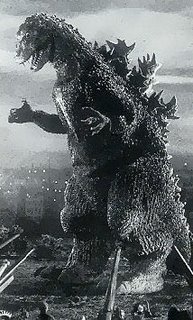THE SIZE OF THINGS.

I remember as a kid watching those ridiculously kitchy Japanese Godzirra movies on sleepy, stormy days, with mom making grilled cheese and tomato soup. God those were the days!!!
Well this article isn't about lazy afternoon food nostalgia, rather commenting on the current status of contemporary art scene, particularly photography and more specifically, talking about the finances and the business of art and its effects on the "SIZE OF THINGS." Taking a gander at photography's current loved ones there are a number of artists including Alec Soth, Katie Gannon, Gregory Crewdson, Andreas Gursky, Thomas Struth, Candida Hofer, Hiroshi Sugimoto, Vik Muniz, Thomas Ruff, Rineke Dijkstra, and Robert Polidori that are taking on works of monstrous proportions that would even make Godzilla blush.

Robert Polidori's current visual anesthesia is viewing at the Metropolitan Museum of Art seems to solidify the idea of big is better. Oh, the mind numbing epicness of it all!
Polidori at the Met
There are many philosophical, emotional, and academic implications in the decision for an artist to create a photographic work large: to create a visual tension and impact through sheer size is the most evident. Would the iconic imagery of Irving Penn's cigarette buds be as powerful if rendered as 8x10" prints? Ever since the mid 80's when Jeff Wall started creating huge lightboxes creating cinematic art tableaux that were derivatives from famous large representational paintings from masters, the size the photographic images have taken, the lush scale and grandiose proportions has been pushed to obscene proportions.
A few weeks ago, I emailed photographer Alec Soth represented by Gagosian Gallery and very gently asked some questions of about why he prices, sizes and editions his work. His comments are posted here on his blog, Alec Soth's Blog.
I respect Alec's work and what he has to say for the most part, but I questioned his gigantic sizes of his prints as just a mechanism to sell his work for more money and I asked him how he feels the bigger is better component plays into the visual integrity of his work. His reply in short, "I understand there is a hunger amongst photographers to talk about these financial matters but I am utterly bored with the topic."
In a recent article in Art Forum discussing the paintings of Julie Mehretu, Christian Haye, gallery director of The Project Gallery in NYC has an equation that sells art by the square foot:
"Can art be priced by the square foot, like carpet? On the stand, Haye testified that the gallery currently sets prices for Mehretu's work in just that manner, using a formula based on the size of the painting: $1,000 a square foot for works over 100 square feet, $1,500 a square foot for works from 50 to 100 square feet, and $2,500 per square foot for works smaller than 50 square feet, with a minimum price of $25,000."
The rise of photography in the contemporary art world has now placed itself on the same pedestal with painters and sculptors. Last year Alec Soth's show was followed only months later by a multimillion dollar Richard Serra extravaganza. In order for photography to take it's rightful place in contemporary art history and in the art market the financial gaps between sculptures-paintings-photographs, has to be relatively bridged.
A collector walks into a Chelsea gallery expects to spend at least $100,000 on art, and is now asked if he is interested in stimulating his collection with 4 photographs for the same price that are from the same series that are hanging in the Whitney. To help photography to command prices that can compete against a Serra, Koons, or Twombly the criteria of the photographic work is not defined by the historical importance of the artist, rather the criteria in question is "Can the work be measured in feet and not in inches?" The economics of multimillion dollar gallerists have dictated that there is a relative equation with size and importance.
Recently, a friend of mine, Emmet Gowin had a surprising exhibition at Pace Macgill in midtown, and the show was simple and beautiful. The photographs were full of wonderous emotion, elements of alchemy, spirituality, created works of one of a kind prints that were painstakingly crafted. I said the exhibition was suprising because the prints were impressively small, fitting the intimacy of the work. The price of the print was dictated by the quality of the image not its physical girth. Needless to say it was refreshing.
Just as modernism and abstraction was a direct act against representation I hope that there are photographers out there that wish to create works that communicate with much power but rely soley on THE SIZE OF THINGS, and leave the work to speak for itself.

0 Comments:
Post a Comment
<< Home